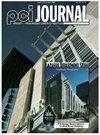Seismic behavior of unbonded post-tensioned precast concrete members with thin rubber layers at the jointed connection
IF 0.9
4区 工程技术
Q4 CONSTRUCTION & BUILDING TECHNOLOGY
引用次数: 7
Abstract
The use of precast concrete members with jointed connections for seismic applications has gained momentum recently; however, these systems may have limited application in seismic regions. This is because their dominant mechanism of impact damping is considered to be inadequate to dissipate the seismic energy imparted to them. With no hysteresis elements, precast concrete members with jointed connections may undergo long durations of motion and large lateral drifts when subjected to seismic loads. This paper investigates a method that can allow these members to dissipate the seismic energy efficiently by having them rock on a thin rubber layer that is placed at the jointed connection. Experiments that examine the use of various classes and layer thicknesses of rubber show that this method can improve damping in these members. Using experimental and numerical data, this paper quantifies the energy dissipation and seismic responses associated with this use of rubber. It is shown that rubber layers with high shore hardness of 90 and thickness between 6.35 and 25.4 mm (0.25 and 1 in.) improve the amount of damping in lateral-load-resisting systems using precast concrete members and produce satisfactory seismic response for these systems. Disciplines Geotechnical Engineering Comments This article is published as Kalliontzis, Dimitrios, and Sri Sritharan. "Seismic behavior of unbonded posttensioned precast concretemembers with thin rubber layers at the jointed connection. PCI Journal 66, no. 1 (2021): 60-76. DOI: 10.15554/pcij66.1-02. Posted with permission. This article is available at Iowa State University Digital Repository: https://lib.dr.iastate.edu/ccee_pubs/284接缝处带薄橡胶层的无粘结后张预制混凝土构件的抗震性能
在地震应用中使用连接的预制混凝土构件最近得到了发展势头;然而,这些系统在地震区的应用可能有限。这是因为它们的主要冲击阻尼机制被认为不足以耗散传递给它们的地震能量。由于没有迟滞元件,具有节点连接的预制混凝土构件在地震荷载作用下可能会经历长时间的运动和大的横向漂移。本文研究了一种方法,通过在节理连接处放置薄橡胶层,使这些构件有效地消散地震能量。通过对不同橡胶等级和橡胶层厚度的试验,表明该方法可以改善这些构件的阻尼。本文利用实验和数值数据,量化了与这种橡胶使用有关的能量耗散和地震反应。结果表明,高邵氏硬度为90,厚度在6.35和25.4 mm(0.25和1英寸)之间的橡胶层提高了预制混凝土构件的侧向荷载抗力体系的阻尼量,并产生了令人满意的地震反应。学科岩土工程评论本文发表于Kalliontzis, Dimitrios和Sri Sritharan。接缝处带有薄橡胶层的无粘结后张预应力混凝土构件的抗震性能。《PCI杂志》第66期。1(2021): 60-76。DOI: 10.15554 / pcij66.1-02。经许可发布。本文可在爱荷华州立大学数字资源库中获得:https://lib.dr.iastate.edu/ccee_pubs/284
本文章由计算机程序翻译,如有差异,请以英文原文为准。
求助全文
约1分钟内获得全文
求助全文

 求助内容:
求助内容: 应助结果提醒方式:
应助结果提醒方式:


